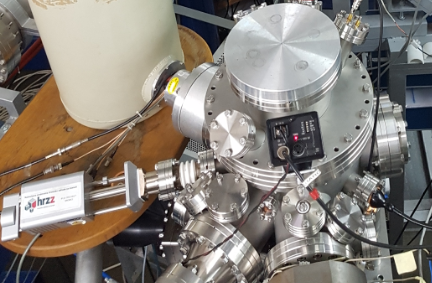Recent technical improvements at the dual-beam/channeling end-station:
- electron beam heater installed and tested
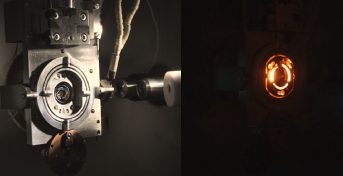
Electron beam heating unit has been installed behind the sample holder and tested. Recently first RBS measurements on selected samples have been performed at different temperatures up to 350 oC.
- focused ion beams in the dual-beam/channeling end-station
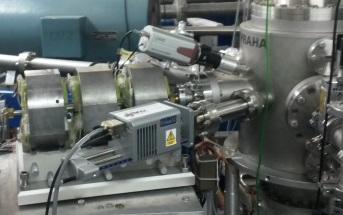 Locally designed and produced quadruple triplet ion focusing lenses have been installed at the 1 MeV Tandetron beam-line in front of the dual-beam/channeling end-station. We plan to test the system in the near future with the aim to introduce focused ion beams in the chamber.The figure shows three lenses on the left and recently installed SSD x-ray detector in front, attached to the vacuum chamber.
Locally designed and produced quadruple triplet ion focusing lenses have been installed at the 1 MeV Tandetron beam-line in front of the dual-beam/channeling end-station. We plan to test the system in the near future with the aim to introduce focused ion beams in the chamber.The figure shows three lenses on the left and recently installed SSD x-ray detector in front, attached to the vacuum chamber.
High-resolution x-ray spectroscopy with ion beams
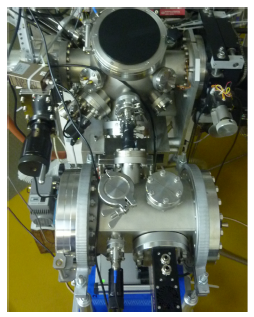
Recently we have developed high-resolution wavelength dispersive µPIXE setup for the ion microprobe to study chemical and solid state effects on characteristic x-rays induced by MeV ion beams. It has been planned to explore a possibility to use this spectrometer within the project for several tasks. As a first step we used the spectrometer to study ion beam induced chemical effects in silicon and its simple compounds (SiO2, SiC, Na2SiO3).
The figure on the left shows the spectrometer vacuum chamber behind the main ion microprobe end-station. The figure below shows Si Kα X-ray intensity distribution for Si, SiO2 and SiC targets induced with 20 MeV carbon ions. Intensities are normalized to KaLo of pure silicon.
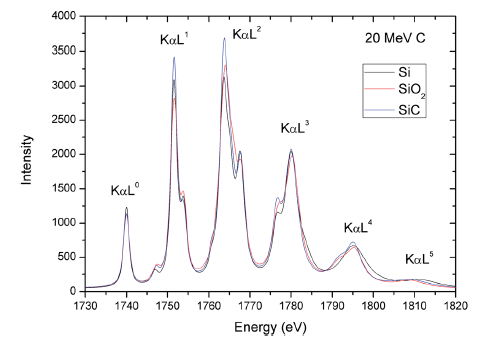
More details are given in two published papers:
- S. Fazinić, I. Božičević Mihalić, T. Tadić, D. Cosic, M. Jakšić, D. Mudronja, Wavelength dispersive µPIXE setup for the ion microprobe, Nucl. Instr. and Meth. B 363 (2015) 61-65.
- Božičević Mihalić, S. Fazinić, T. Tadić, D. Cosic and M. Jakšić, Study of ion beam induced chemical effects in silicon with a downsized high resolution X-ray spectrometer for use with focused ion beams, Journal of Analytical Atomic Spectrometry 31 (2016) 2293-2304.
On the threshold for ion track formation in CaF2
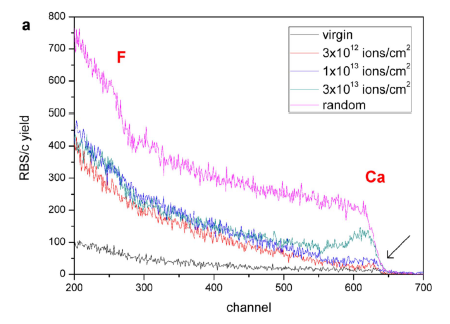
There is an ongoing debate regarding the mechanism of swift heavy ion (SHI) track formation in CaF2. Recently we performed a study to shed light on this important topic using a range of complementary experimental techniques. As ilustration, the figure shows RBS/c spectra after 23 MeV Iodine irradiation. The applied fluences were 3×1012 ions cm−2, 1×1013 ions cm−2, and 3×1013 ions cm−2. For comparison, RBS/c spectra from unirradiated sample are given, both in channelling and in random orientation. Marked are Ca and F edges in the RBS/c spectrum and arrow points to the surface peak. More details are given in the recently published paper:
– M. Karlušić, C. Ghica, R.F. Negrea, Z. Siketić, M. Jakšić, M. Schleberger, S. Fazinić, On the threshold for ion track formation in CaF2, New Journal of Physics 19 (2017) 023023
New chamber for the dual-beam end-station
New chamber has been designed and installed to enable measurements of RBS-RBSc, PIXE-PIXEc, PIGE, NRA, IBIC, IBIL measurements. The old channeling end station has been installed at another beam line. The focusing-scanning system has been tested and good capabilities to perform ion microbeam measurements have been demonstrated.
